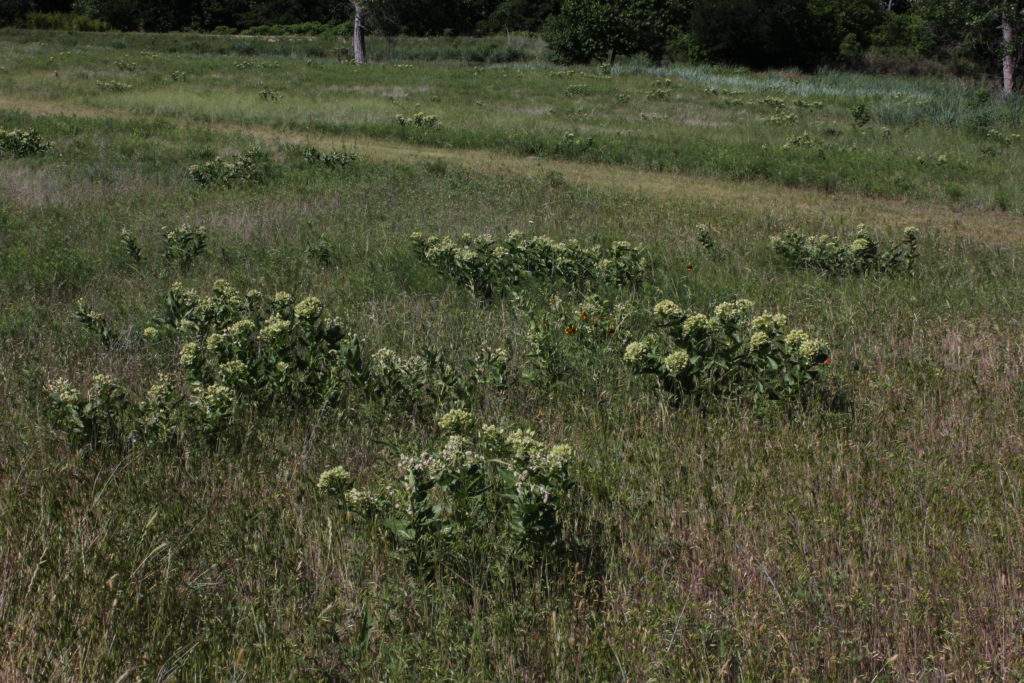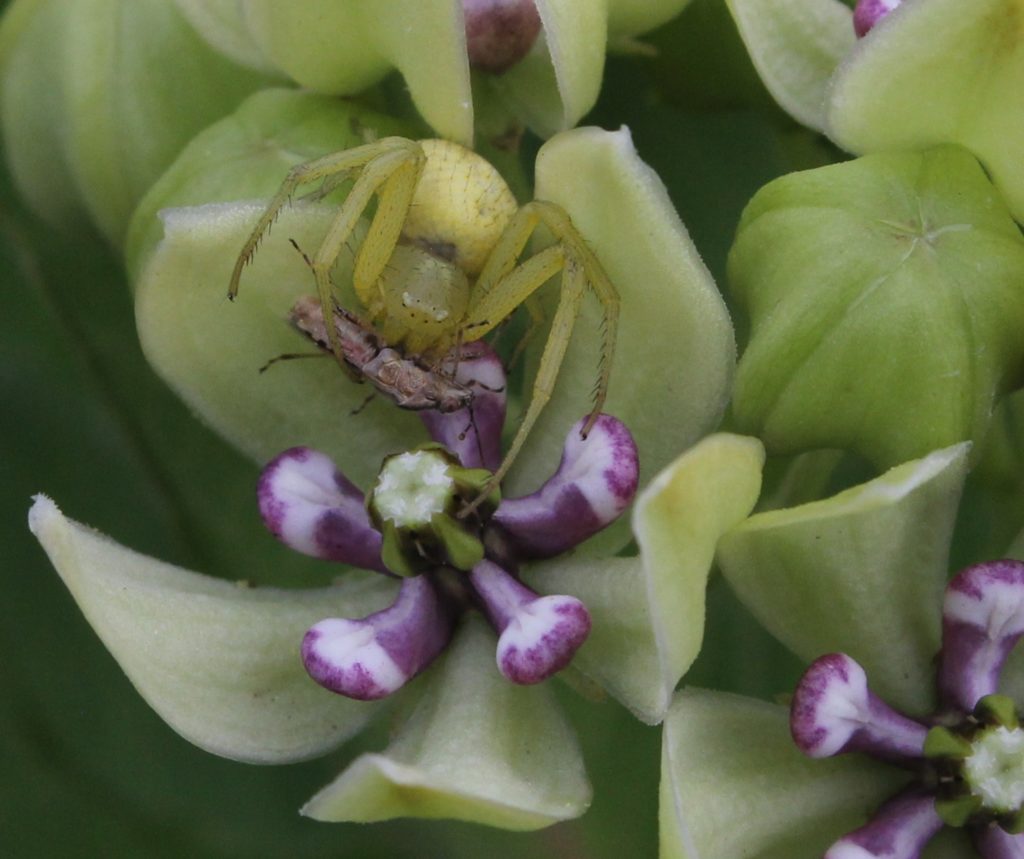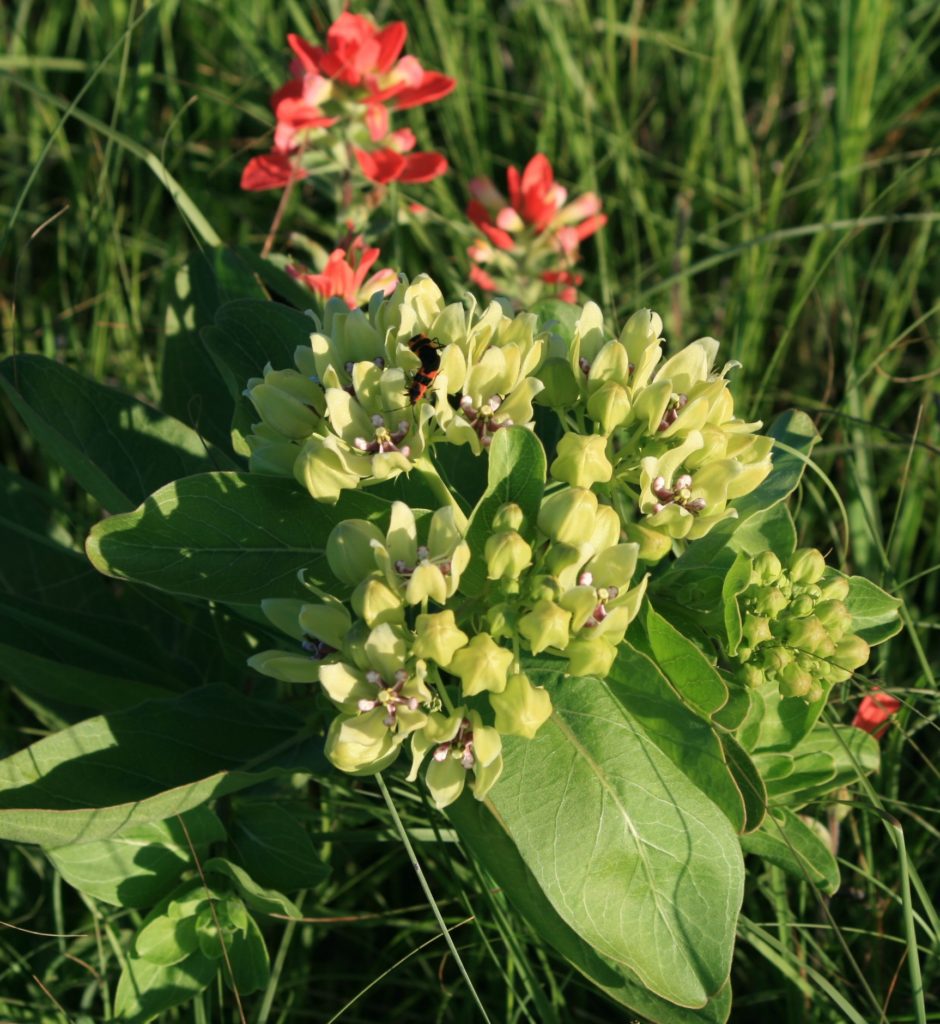Green Milkweed is a fantastic plant! It just needs a new publicist.
In a sensible world it would have been Green Milk Marvel or Green Prairie Magic, or something else that conveys a sense of its worth and beauty. “Weed” is a harsh term, and a sad thing for a plant to be saddled with, and most likely Green Milkweed just got painted with the same broad brush that some of its more unruly cousins got painted with. It’s formal name, Asclepias viridis, is at least easier to remember than some, since “viridis” literally means “green” in Latin.

It’s not fussy about soil type, growing in both acidic sandy loams and heavy alkaline clay soils. It doesn’t require rich soils either. It grows even in thin poor soils above rock, but won’t get as big there. It’s also not fussy about moisture conditions. Once established, it can take hot dry conditions and also doesn’t mind occasional flooding and soggy soils as long as it dries out some times. It will pretty much take what you throw at it. It loves full sun, but will persist for years in the shade even if it doesn’t bloom there.

I’ve even grown it in a large pot. I lost my large potted one after five growing seasons during an unusually cold and wet winter. I think it just couldn’t take that much cold while it was wet. Being above ground in a pot with no protection, plants feel like they are exposed to even colder temperatures than if they were in the ground. Somewhere I read (a long time ago!) that the soil temperature in a raised pot is likely to be ten degrees cooler than the soil temperature in the nearby ground on a cold night.

It’s not surprising, with its flexibility about growing conditions, that it grows in the whole eastern half of the state of Texas, and throughout many other states too. From east to west and north to south in its native range, temperature extremes and average rainfall vary widely.
You can check its range map here to see if it’s native to your area. The bright spring green colors on this map mean it has been recorded for that county. If your county is surrounded by bright green but is not that color, it probably is found there, but nobody has collected an official specimen from there.

Green Milkweed grows mostly upright, gently spreading into a “V” shape from a central point. It’s overall height is seldom more than two feet, and frequently closer to one foot. However, in a garden in my town I did see one super achiever plant that was three feet tall and covered with seedpods where it had bloomed. The garden soil was rich, loose and well drained, with a watering system. The plant had everything a plant could ask for. It’s usual spread is no more than 18 inches, but a very old or very happy plant may be two feet across.

Unlike many Milkweeds, the leaves on a Green Milkweed are not strictly opposite. It may have young leaves and lower leaves that are opposite, but most of the leaves on a mature plant will be alternate along the stalk. If you’ve never thought about opposite and alternate leaves, here’s a trick to help you remember: Your arms are attached to your body like opposite leaves are attached to a stem—right across from (opposite of) each other. Your right arm and your left leg are attached to your torso more like alternate leaves are attached (leaf, stem, and then the other leaf).
Like other Milkweeds, Green Milkweed makes pods (technically, follicles) that are filled with seeds neatly arranged in rows. Each seed is attached to a fluffy white parachute that enables the seeds to fly to new locations. Some say the upright pods look a bit like antelope horns, and some people call the plant Green Antelope Horns Milkweeds. I think there are good reasons not to do that, so I stick with “Green Milkweed”–just like the Latinized name says.



Green Milkweed is not a species of Milkweed that sends out shoots forming a colony. It has a starchy taproot like a long potato that anchors the plant in one spot and allows it to store water and nutrients when conditions are good.

Gophers sometimes chew off the roots from below, but normally don’t eat the whole thing. The plant responds by sending out a couple of new branches on the tuber, but it still doesn’t make colonies like some Milkweeds do. One plant can be in exactly the same spot for decades.
Native Milkweeds in Texas have a superpower that serves them well. They have the ability to go dormant when things get too hot, too cold, or too dry, and then to re-sprout from reserves in their taproot once good growing conditions return. When conditions are good they’ll recharge that taproot with new stores of water and energy-rich starches. In some years, all our milkweeds are dormant by July and then re-sprout in the fall, but in some years they stay out and green all summer, even blooming a second or third time. The plants know when to pack it in and conserve energy. You won’t have to decide for them.

In the wild, Green Milkweed is very seldom found growing right next to another plant of its own species. They seem to naturally not sprout (or live to maturity) within a few feet of another Green Milkweed.

I like to respect a plant’s wishes and mimic what nature does when I plant things in my garden, so I keep mine spaced out. Some plants actually have the ability to chemically sabotage certain other plants that try to grow too close. I don’t know if Green Milkweed does, but it would not surprise me at all if some researcher eventually decides that it can prevent seedlings of the same species from growing nearby. It’s what it naturally seems to do in the field.

Speaking of seedlings sprouting, some research does indicate that fewer than one half of one percent of the Milkweeds seeds that are loosed by a plant under natural conditions in the wild become Milkweed seedlings that get old enough to be second year plants—one out of every two hundred. That’s not a great recruitment rate, so it’s a good thing mature plants live a long time.

Tiny seedlings may be eaten by small animals before they develop their poisonous and bitter latex sap. Friends tell me one rat in a greenhouse can wipe out a whole tray of Milkweed seedlings overnight. Outside, some seeds will get eaten or buried and simply never sprout. The seedlings need to stay continuously moist but not soggy for about three months until their taproot formation is under way. Fungus will kill some sprouts if they stay too wet. In North Texas, where high winds, high temperatures and dry weather can wither things in an afternoon, and torrential rains can cause flash flooding, that means a seed/sprout has to be pretty darned lucky to find all those conditions just right and escape being eaten in a given year. I tell you all this to say that although each seed pod (really called a follicle, but who does that?) contains about 100 seeds, you won’t find these seedlings taking over your garden. When I actually work at growing them from seed, the rabbits almost always devastate the sprouts. A plant that has been growing for a few months develops a nasty tasting sap that prevents most mammals from eating it after that.

So why am I so in love with this plant? It’s a pollinator powerhouse. Monarch Butterflies, Queen Butterflies, and the Unexpected Cycnia Moth all need Milkweeds for their caterpillars to eat, but so many other butterflies large and small stop by to gather nectar. The leaves are just the right texture and emerge at just the right time to really please the Monarchs. It’s one of the Milkweeds most frequently chosen for egg laying when Monarchs have a choice of plants. I sometimes see male Monarchs simply flying patterns over a patch of Green Milkweeds. They are “patrolling” their chosen patch and will chase away anything orange, yellow or red that gets into their territory. They recognize the plants as good ones for egg laying and are waiting for the female Monarchs to happen along.



Colorful beetles in all shapes and sizes seem attracted to the plants, and some of those beetles actually need Milkweeds to survive too. While native bees and Honeybees probably don’t have to have Milkweeds, they sure appreciate its rich nectar, and are frequent visitors. It’s truly a hub of life in a prairie or in a garden, and it deserves to be given wider consideration as a garden plant in home settings.



I also happen to think it’s pretty. Its lavender hoods contrast with the soft green of its petals, spreading wide, but not reaching out as far as the petal tips. The loose blousy irregular look of its flower heads is charming to me, and looks a little free spirited to my eye. A single plant may have multiple bloom heads, and older plants in reasonable conditions tend to send up many stems each year.



Maybe there’s space in your garden for one or more Milkweeds this year. I always recommend that people try to plant milkweeds native to their own area, and I’m so glad Green Milkweed is native to mine!